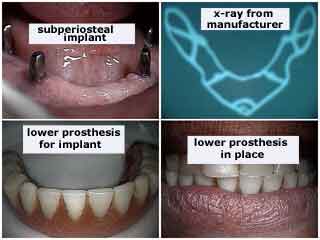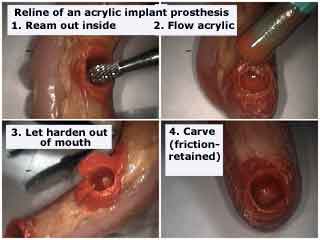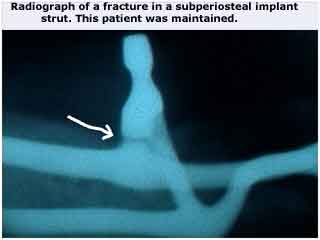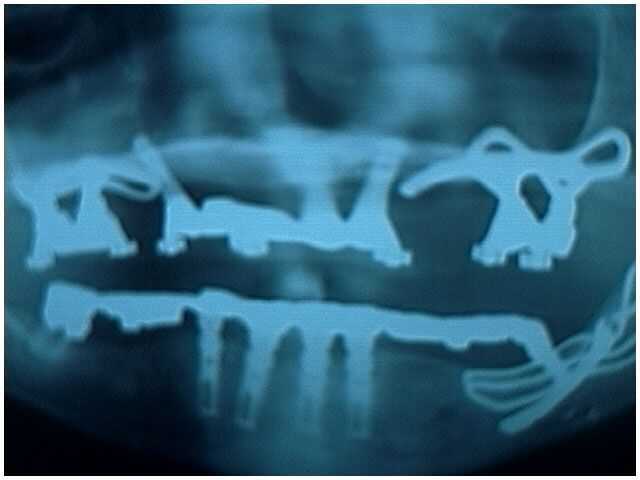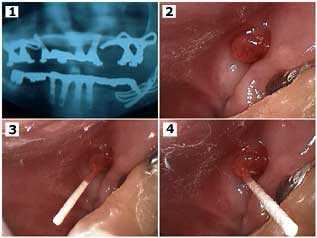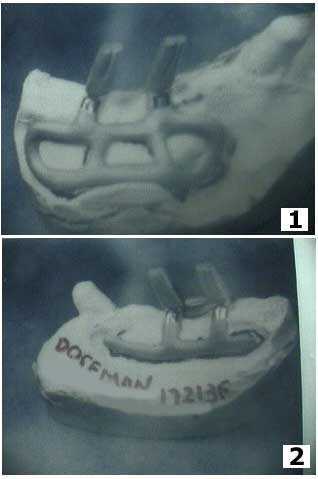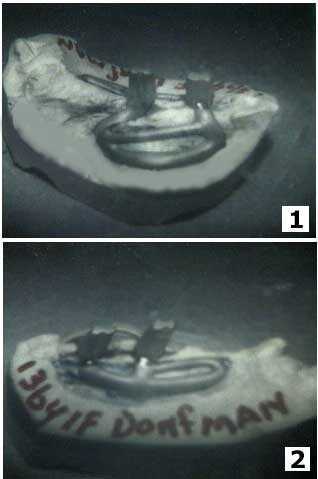Before and after photos on subperiosteal dental implants and hybrids performed in our dental implants office.
A subperiosteal dental implant can also be called a subperiosteal implant or just a “sub.” They do work and can last for decades in patients who have little or no jaw bone for more conventional dental implants. Subperiosteal dental implants have been around and used for nearly fifty years.
Read Dr. Leonard Linkow – four of his classic textbooks are reproduced with permission and exclusively available for free at www.NYCdentist.com/Linkow.
Learn more by reading Page
126 of Mandibular Implants by Dr. Linkow.
Reline of an acrylic dental implant prosthesis – dental bridge teeth – over a subperiosteal dental implant. Review section in the Left Margin on Intramucosal dental implants; might subperiosteal dental implants be a safer dental implant to offer Osteoporosis patients who have taken Bisphosphonates like Fosamax and are at a higher risk of developing Ostenecrosis of the Jaw, ONJ? Read the Dental Textbooks section at the Top of this page to decide. Subperiosteal implants began to fall out of favor in the mid 1980’s as osseointegrated dental implants began to gain in popularity. Very few current implant dentists know how to perform subperiosteal dental implant surgery and implant prosthetics. It’s a shame because they do work!
Radiograph x-ray of a strut fracture in a 15 year old subperiosteal dental implant. This strut did not create a problem and did not require treatment.
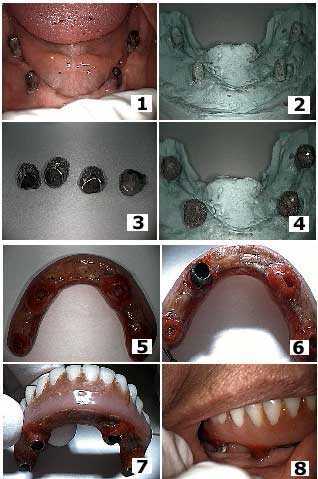
How to Pictures – Retrofitting telescopic copings under an all-acrylic dental bridge teeth prosthesis over a full mandibular subperiosteal dental implant. This implant and prosthesis is over 15 years old. The all-acrylic prosthesis had been successfully retained with a small amount of denture adhesive over the dental implant abutments. The patient would return about twice a year to reline the acrylic of the prosthesis that would wear over time against the subperiosteal implant posts. The patient wanted to reduce the frequency of these relines. 1) Full mandibular subperiosteal dental implant. 2) Master model. 3) Four telescopic copings were fabricated to fit over the implant posts and had roughened outer surfaces for incorporation into the acrylic prosthesis. 4) The four copings on the model. 5) The underside of the all-acrylic dental implant prosthesis. 6) One coping being incorporated into the prosthesis at a time. The acrylic in the immediate area had been removed to allow the prosthesis to seat over the coping, then flowable self-curing acrylic was relined over it. 7) The prosthesis with all four copings attached. 8) An intra oral photo of the dental bridge with the telescopic copings attached.
Combination of dental implants. Three unilateral subperiosteal dental implants (two in the maxilla and one in the mandible) that vary in age from 5-16 years, seven anterior implants (three in the maxilla and four in the mandible) that vary in age from 3-11 years, and one lower posterior molar with a telescopic coping that has remained intact for 16 years.
You can learn more by reading Page 140 of Maxillary Implants by Dr. Linkow.
An oral microbiology culture was taken from a draining fistula around a maxillary unilateral subperiosteal dental implant. Cultures should be obtained before prescribing antibiotics. This infection was resistant to Penicillin, Tetracycline and Metronidazole. This infection resolved and did not return for 17 years of follow up.
Pictures of a unilateral maxillary subperiosteal dental implant on a master model. This type of dental implant can be placed where a patient has little or no bone for more traditional endosteal dental implants. They may require more long term maintenance than other types of dental implants but they can work well in the hands of experienced dentists.
Pictures of a unilateral maxillary subperiosteal implant on a master model. Experienced subperiosteal dental implant labs like the manufacturer of this beautiful custom unilateral sub are rare.
Read Dr. Leonard Linkow – four of his classic textbooks are reproduced with permission and exclusively available for free at www.NYCdentist.com/Linkow.
